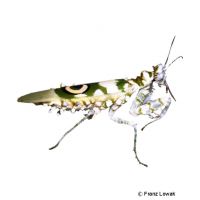African Flower Mantis (Pseudocreobotra ocellata)
| African Flower Mantis Pseudocreobotra ocellata | |
|---|---|
| Name | African Flower Mantis |
| Name Lat. | Pseudocreobotra ocellata |
| Family | Flower Mantids |
| Family lat. | Hymenopodidae |
| Order | Praying Mantids |
| Order lat. | Mantodea |
| Origin | Africa |
| Habitat | Shrub savanna |
| Diet | Flying insects |
| Humidity | 50-70 % |
| Behavior | Predatory |
| Keeping | Individual |
| Care Level | Easy |
| Housing | Semi humid terrarium |
| Breeding | Moderately difficult |
| Life Span | 3-10 months |
| Protection | No |
| Metric Units | |
| Size | 3-4 cm |
| Temperature Day | 25-35 °C |
| Temperature Night | 20-22 °C |
| Housing Size | 20 x 20 x 30 cm |
| US Units | |
| Size | 1.2"-1.6" |
| Temperature Day | 77-95 °F |
| Temperature Night | 68-72 °F |
| Housing Size | 10" x 10" x 10" |
Distribution and habitat
The diurnal flowering mantis is native to West and East Africa from Angola to Mozambique. There it lives in the bush and grassland on the flowers of various shrubs and is also found as a cultivator in gardens
Maintenance
For a female an insectarium of 20 x 20 x 30 cm (L x W x H), for a group of up to 5 males 30 x 30 x 50 cm, can be recommended as a guideline, which should be placed in a quiet place without sunlight. A cover of gauze or fine metal mesh is recommended.
You will need an insectarium structured with thin, strongly branched climbing branches (hiding places, privacy screens), dense planting and flowers (also artificial), as well as a small, shallow drinking vessel with water gel or a cotton trough. Artificial or live plants (e.g. Ficus pumila, Scindapsus aureus) can be used for decoration. The substrate of coconut fiber, vermiculite or sand-clay-peat mixture (terrarium humus) should always be kept slightly moist. Every 2-3 days the insectarium should be finely sprayed with water inside (humidity), but a rain or mist system is better. Waterlogging should be avoided at all costs.
| Temp. day: 25-35 °C | Temp. night: 20-22 °C | Humidity: 50-70 |
The lighting duration should be 12 hrs. Light sources that also produce the necessary heat are ideal.
Diet
They are predatory and seize the prey, preferably flying insects, with lightning speed from an angled lying-in-wait position with their tentacles. The food supply should consist of crickets, house crickets, flies (Drosophila) and grasshoppers as well as small arachnids. It is important to regularly add minerals and vitamins (e.g. by dusting the feeders). The quality of the feeders can be enhanced by feeding overripe fruit and honey water. A few days before, during and after molting, they refuse to eat. During molting, no predatory feeders (e.g. crickets) should remain in the insectarium, as during this time the animals are unprotected and may become prey themselves.
A varied diet promotes health and prevents deficiency symptoms.
Reproduction and breeding
The females are slightly larger and more massive than the males. The males have 6 appendages of equal length on the abdomen, the females only 5.
After mating, which lasts up to 14 hours, the female lays the first egg package (ootheca) after about a week, 4-8 more can follow. At a temperature of about 30 °C and a humidity of 60-70 % the nymphs hatch after about 4-6 weeks. The young are small, black and resemble ants (mimicry). They should be fed immediately with small fruit flies or microheims so that they do not eat each other (cannibalism).
After imaginal molting, males take 10 days, females 14 days to reach sexual maturity. After that the males live for about 3-5 months, the females up to 10 months.
Important
Before mating, the female should be offered a large food animal to reduce the risk of her eating the male. It is recommended to keep females singly, males can be kept in a group (approx. 5 animals)
The flower mantis can easily be confused with Pseudocreobotra wahlbergii, which is slightly larger.
They have very good camouflage due to their body shape and coloration, and their often prolonged immobility. When in a threatening posture, they place their wings to the side and display their usually lemon-yellow eyespot as a deterrent.
Before purchasing, an insectarium should be prepared that meets the species specific needs. Good ventilation without drafts is necessary, as well as equipment for measuring temperature and humidity. The lighting must correspond to the day-night rhythm appropriate for the species and must be installed in such a way that the animals cannot injure themselves. The insectarium should be locked in such a way that neither unauthorized persons can open it nor the animals can escape. Special attention must be paid to thorough hygiene and contamination must be removed regularly.
Further literature can be found in your pet store.
References
Text: petdata; Image: Franz Lowak
Source: HENKEL & SCHMIDT (2010): Taschenatlas Wirbellose für das Terrarium, Verlag Ulmer; ENGELMAN & LANGE (2011): Zootierhaltung - Tiere in menschlicher Obhut: Wirbellose, Verlag Harri Deutsch
